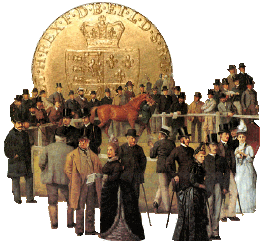| Thoroughbred Heritage |
| Maher's Horse Sales Price Equivalents in Today's U.S. Dollars |

|
The Value of a Pound From 1815 to the beginning of World War I (1914) the currency of major world nations was exceptionally stable, ensured by its convertability to precious metals--gold in most nations, silver in some. Great Britain was the most powerful and influential trading nation throughout the 19th century, and throughout most of the 1800s the value of 1 pound (and after 1816, the sovereign) held steady at $4.8667, usually rounded off to $5.00. This value was retained, with minor fluctuations, until a major devaluation occured in 1949, and again, in 1967. This makes it comparatively easy to convert racehorse winnings and auction prices in Great Britain in the first half of the twentieth century to dollars, and be reasonably close to the value: use $5.00 for each pound, and $5.25 for each guinea. Converting to Today's (Year 2000) Prices After converting to dollar value, the value of inflation needs to be calculated; in other words, what would be the equivalent value, in today's dollars, of a racehorse purchased for 12,000 guineas in 1925? Robert Sahr, of the political science department at Oregon State University in Corvallis, has created a chart based on the consumer price index, which offers conversion factors (CF) to give an approximation of value. To take our example, based on the record-breaking Doncaster sales price of the Maher-bred filly, Fête, the conversion factor for the year 1925 in his chart is .102. Her dollar value, therefore, was: 12,000 guineas x $5.25 = $63,000.00 in 1925. Her year 2000 value, therefore, is approximately: $63,000 in 1925 = $63,000/.102 = $617,647.00 So, the pretty, and ultimately useless Fête sold for what would be the equivalent of over half a million dollars in today's market. Here are the Conversion Factors from Professor Sahr's chart for the Maher years (pdf documents of this chart and others can be downloaded from http://www.orst.edu/dept/pol_sci/fac/sahr/sahr.htm): |
| YEAR | CF | YEAR | CF | YEAR | CF |
| 1902-1911 | .052 | 1920 | .116 | 1929 | .099 |
| 1912 | .058 | 1921 | .104 | 1930 | .097 |
| 1913 | .057 | 1922 | .096 | 1931 | .088 |
| 1914 | .058 | 1923 | .099 | 1932 | .080 |
| 1915 | .059 | 1924 | .099 | 1933 | .076 |
| 1916 | .063 | 1925 | .102 | 1934 | .078 |
| 1917 | .074 | 1926 | .103 | 1935 | .080 |
| 1918 | .088 | 1927 | .101 | 1936 | .081 |
| 1919 | .101 | 1928 | .099 | 1937 | .084 |
|
What are Guineas, Anyway? Guineas were first issued in 1666, during the reign of King Charles II. Their name derived from the principal source of gold for the original issues, Africa, brought to England by the Africa Company. Initially, guineas were valued at one pound or twenty shillings. The guinea fluctuated in value until the reign of William III, which stablized its value, although it underwent some additional revaluing subsequently. The last guinea coinage was minted in 1813 (replaced in 1816 by the machine-pressed sovereign, with a value of one pound sterling), but as a monetary unit it continued to be used until 1971, particularly for luxury items, such as racehorses. Its value was the equivalent of twenty-one shillings, written £1/1/, 21s., 21/-, or £1.05 (the pound, again, was the equivalent of twenty shillings). The guinea shown on the Maher page and in the graphic above is one minted during the reign of George III, called the "spade guinea," or "spade ace." |
|
And the Quote? "When I was one-and-twenty I heard a wise man say, 'Give crowns and pounds and guineas But not your heart away; Give pearls away and rubies But keep your fancy free.' But I was one-and-twenty, No use to talk to me." --From A Shropshire Lad(1896) by Alfred E. Housman |